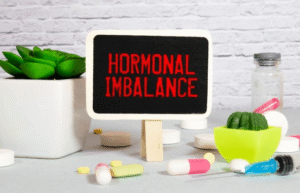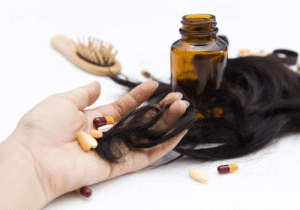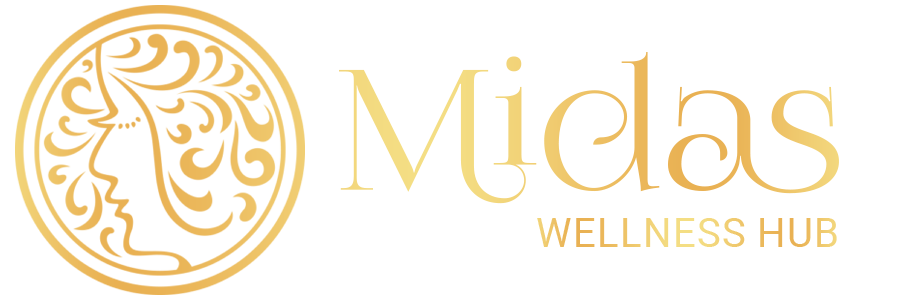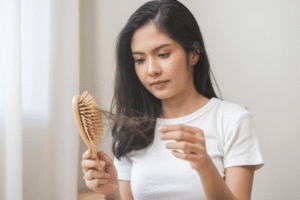
Postpartum Hair Loss: Why It Happens and How to Manage It

Postpartum Hair Loss: Why It Happens and How to Manage It
Bringing a baby into the world is one of life’s most beautiful experiences. From the soft snuggles to the midnight feeds, every moment feels new, tender, and life-changing. But amidst this whirlwind of change, there’s one surprise many new moms quietly face: postpartum hair loss. One day you’re brushing your hair, and suddenly, you notice more strands in your hands than you ever expected.
If this sounds like you, take a deep breath. You’re not alone. And most importantly, this is completely normal.
In this blog, we’re walking with you through what postpartum hair loss really is, why it happens, and how you can gently support your hair and scalp during this delicate time.
What Is Postpartum Hair Loss?
Postpartum hair loss is the hair shedding that many women experience a few months after giving birth. It’s not permanent, and it doesn’t mean something is wrong. In fact, it’s your body’s natural way of rebalancing after the incredible hormonal shifts that happen during and after pregnancy.
During pregnancy, your estrogen levels rise significantly. This hormone helps keep your hair in the growth phase longer, which is why many women feel their hair is thicker and shinier during those nine months. But after delivery, estrogen levels drop quickly. As a result, a large number of hair follicles enter the resting phase and eventually fall out, all around the same time.
This shedding usually starts around the second to fourth month postpartum and can last for several weeks or months.
Why Is It So Common?
The short answer is: hormones. Your body goes through a massive shift in hormone levels after delivery. Estrogen, which helps keep your hair from falling out during pregnancy, decreases rapidly after childbirth. That sudden drop causes hair to enter the shedding phase.

You’re not losing more hair than usual, you’re just losing all the hair you held onto during pregnancy, now all at once. For many moms, this sudden change can feel overwhelming, but it’s important to remember that it’s temporary.
When Does It Stop?
Postpartum shedding usually begins between 2 to 4 months after delivery. For most women, it slows down by the 6-month mark and settles completely by your baby’s first birthday.
If you’re breastfeeding, the hormonal balance might take a little longer to stabilize, so you might notice hair fall continuing a bit beyond six months. As long as your overall health is fine and you don’t notice bald spots or other symptoms, your hair will naturally grow back in time.
How to Care for Your Hair During Postpartum
You’re already caring for a new baby, the last thing you need is a complicated routine. So here’s a gentle, nurturing approach to help your hair recover and thrive.
1. Be Kind to Your Hair
Use a soft, wide-tooth comb and avoid pulling or tugging while detangling
Try loose hairstyles instead of tight buns or ponytails
Avoid heavy heat styling tools like straighteners and curling irons for a while
Your hair is in a sensitive phase. Treat it like you would your newborn, gently and lovingly.
2. Focus on Nutrition
Your body needs nourishment, and so does your hair.
Focus on a diet rich in:
- Iron (spinach, lentils, dates)
- Protein (eggs, paneer, legumes)
- Omega-3 fatty acids (flaxseeds, walnuts)
- Biotin & Zinc (nuts, sweet potatoes, whole grains)

These nutrients not only help with hair growth but also support your overall postpartum recovery. If you’re considering supplements, always check with your doctor first, especially if you’re breastfeeding.
3. Oil Massages for the Win
A warm oil massage can be incredibly relaxing and healing. Try coconut oil infused with curry leaves or almond oil with a few drops of rosemary essential oil. Massage it gently into your scalp once or twice a week, leave it in for an hour, and then rinse with a mild shampoo.
Not only does this improve circulation, but it also gives you a few moments of calm amidst your busy days.
Read more: https://midaswellnesshub.com/blog/does-ayurvedic-oil-massage-help-with-hair-fall/
4. Switch to Gentle Hair Products
Look for sulfate-free, fragrance-free shampoos that are easy on the scalp. Use a lightweight conditioner, focusing only on the mid-lengths and ends. Avoid heavy, chemical-based products during this time, think clean, natural, and minimal.
Your Scalp Deserves Love Too
At Midas Wellness Hub, we truly believe in healing from the roots. That’s why our scalp treatments focus on balancing your scalp’s microbiome, the healthy bacteria that support hair growth and reduce sensitivity. A soothing scalp detox or facial once a month can do wonders. You don’t need to go overboard. Even a simple in-clinic session or an at-home scalp massage ritual can help you reconnect with yourself.
What If It Feels Like Too Much?
If your hair loss continues beyond 12 months, or you notice bald spots, extreme thinning, or an itchy, irritated scalp, it’s a good idea to check in with a dermatologist. Sometimes, postpartum hair loss can be a sign of:
- Thyroid imbalance
- Low iron levels (anemia)
- Vitamin D or B12 deficiency
- Stress-related hair fall
Your doctor can help rule out any underlying causes and guide you with gentle, safe solutions.
How to Feel Good While It Grows Back
While your hair is growing back (and it will!), here are a few ways to feel more confident in the meantime:
Style your baby hairs, they’re a sign of new growth!
Try headbands, silk scarves, or stylish clips
Go for a layered haircut or trim to freshen up your look
Use light serums or leave-in sprays that protect hair without weighing it down
Most importantly, remind yourself every day that this phase is temporary, but your strength and beauty are lasting.
Final Thoughts from the Midas Team
Postpartum hair loss can be emotional. It can feel like one more thing that’s out of your control. But it’s also a reminder that your body is doing something incredible, healing, rebalancing, and restoring itself after bringing new life into the world.
With a little care, patience, and support, your hair will find its way back, just like you are.
At Midas Wellness Hub, we’re here for every chapter of your wellness journey. Whether it’s a calming scalp treatment, a nourishing product, or a simple reminder that you’re doing an amazing job, we’re with you every step of the way.
You’re not just growing hair back. You’re growing into a new version of yourself. And she’s beautiful.
FAQs
Yes, it’s completely normal. Most new mothers experience noticeable hair shedding 2 to 4 months after giving birth. It’s your body’s natural way of adjusting after the hormonal changes of pregnancy.
Postpartum hair loss usually peaks around 4 months postpartum and gradually improves. For most women, it slows down by 6 months and settles by your baby’s first birthday.
During pregnancy, high estrogen levels keep your hair in a growth phase. After delivery, estrogen drops, and a large number of hairs enter the shedding phase at the same time, this is what causes the sudden hair fall.
In most cases, yes. Your hair may take a few months to regrow, but with proper care and nourishment, it typically returns to its normal thickness and texture within a year.
Be gentle with your hair, maintain a balanced diet, oil your scalp regularly, use sulfate-free products, and manage stress. Supporting your body from the inside out is key.

